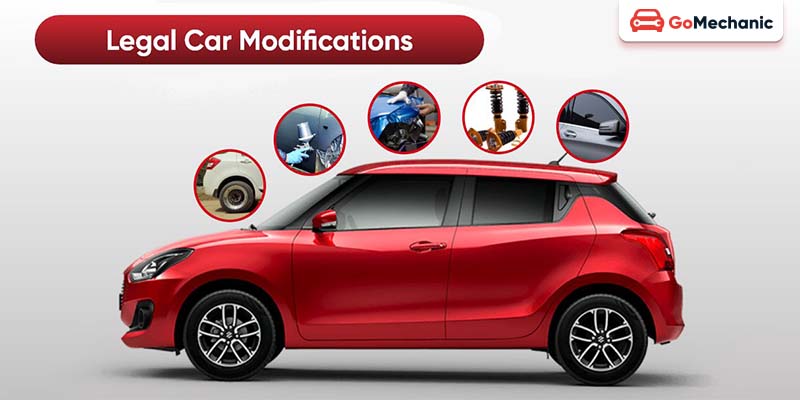Car modifications have become a popular trend among vehicle enthusiasts in India. From performance enhancements to aesthetic upgrades, car owners are constantly seeking ways to personalise their vehicles. However, amidst the excitement of customising their cars, many individuals overlook the legal aspects governing these modifications. In this article, we will delve into the realm of car modifications in India, exploring what’s legal and what’s not.
Introduction
Car modifications involve changes made to a vehicle to enhance its performance, appearance, or functionality. These modifications can range from minor adjustments, such as installing custom lighting, to major overhauls, like altering the engine or suspension system. The world of car modifications is diverse, with enthusiasts around the globe customising their vehicles to suit personal tastes and practical needs.
Overview of Car Modifications:
Performance Enhancements
- Engine Upgrades: Increasing engine power for better speed.
- Exhaust Systems: Tuning for efficiency and sound.
- Suspension Improvements: Enhancing handling and stability.
Cosmetic Alterations
- Custom Paint Jobs: Personalising with unique colours and designs.
- Body Kits: Modifying body shape for aesthetics or aerodynamics.
- Spoilers and Rims: Adding style and improving aerodynamics.
Functional Upgrades
- Audio System Upgrades: Enhancing sound quality.
- Advanced Navigation Systems: Incorporating cutting-edge GPS technology.
- Accessibility Modifications: Adapting vehicles for drivers with disabilities.
Safety Improvements
- Advanced Braking Systems: Installing superior brakes for better control.
- Roll Cages: Enhancing structural integrity for safety.
- Upgraded Headlights: Improving visibility during night driving.
Importance of Understanding Legal Regulations:
Safety Compliance
- Risk Prevention: Ensures modifications do not compromise safety.
- Visibility Issues: Addresses modifications like overly tinted windows that can hinder the driver’s visibility.
Environmental Regulations
- Emission Standards: Adhering to laws that limit pollution from vehicles.
- Exhaust Modifications: Understanding how changes can impact emission levels.
Insurance Implications
- Coverage Conditions: Recognizing how modifications might affect insurance terms.
- Policy Validity: Ensuring that all modifications are declared to prevent voiding of coverage.
Resale Value
- Market Appeal: Legal modifications can maintain or increase the car’s resale value.
- Penalties and Fines: Avoiding illegal modifications that could incur costs and reduce value.
Legal Framework for Car Modifications in India
Legislation Governing Car Modifications:
In India, the regulation of vehicle modifications is primarily governed under the Motor Vehicles Act, 1988 and the Central Motor Vehicle Rules, 1989. These laws specify what changes are permissible and which are not, to ensure safety, reliability, and environmental compliance. Key aspects include:
- Structural Changes: Any structural modifications to the vehicle chassis or engine require approval from the Regional Transport Office (RTO).
- Safety Norms: Modifications must not compromise the vehicle’s compliance with safety standards.
- Environmental Compliance: Changes that may affect emissions, such as altering the exhaust system or engine tuning, must adhere to the Pollution Under Control (PUC) standards.
Regulatory Bodies Overseeing Modifications:
Several bodies and authorities are involved in overseeing vehicle modifications in India:
- Regional Transport Offices (RTOs): These local authorities are responsible for enforcing vehicle regulations in their respective regions, including the approval of significant modifications.
- Automotive Research Association of India (ARAI): This body is tasked with testing and certifying vehicles and their components to ensure they meet required standards.
- Central Pollution Control Board (CPCB): It monitors modifications affecting vehicle emissions to ensure compliance with environmental norms.
Legal vs. Illegal Car Modifications
Understanding what constitutes legal and illegal car modifications is crucial for any vehicle owner interested in customising their ride. Here’s a comprehensive breakdown of some common modifications and their legalities:
Examples of Legal Modifications
- Engine Upgrades: Permissible as long as they comply with emission standards and do not adversely affect the vehicle’s safety features.
- Suspension Lifts or Drops: Allowed within legal limits and should not compromise vehicle stability.
- Exhaust System Enhancements: Legal if they adhere to noise and emission regulations.
- Window Tinting: Acceptable when the tint allows a specified percentage of light to pass through, according to regional laws.
- Wheel and Tyre Changes: Approved as long as the new wheels and tyres are suitable for the vehicle and meet safety standards.
- Cosmetic Paint Jobs and Wraps: Generally legal, except for designs that mimic police or emergency vehicles or include prohibited symbols.
Examples of Illegal Modifications
- Emission Control Tampering: Includes removing or disabling devices like catalytic converters.
- Excessive Window Tinting: Tints that do not meet the legal minimum visible light transmission levels.
- Unauthorised Lighting: The use of colours typically reserved for emergency vehicles (like blue or red) or excessively bright lights that can impair the vision of other drivers.
- Loud Exhaust Systems: Systems that produce noise levels beyond legal limits.
- Extreme Structural Modifications: Alterations to the vehicle’s frame without proper authorization, potentially compromising its structural integrity.
- Illegal Decals or Wraps: Those that impersonate law enforcement or feature offensive/obscene graphics.
Safety Regulations in Vehicle Modifications
Importance of Adhering to Safety Standards
- Protection of Occupants and Other Road Users: Ensures modifications enhance rather than compromise safety, maintaining vehicle integrity.
- Legal Compliance: Adherence to regional regulations avoids legal issues, ensuring modifications are within legal bounds.
- Insurance Validity: Keeping modifications within approved guidelines prevents voiding of insurance coverage.
- Resale Value: Compliant modifications often maintain or increase the vehicle’s market value, attracting informed buyers.
Consequences of Non-Compliance
- Legal Penalties: Non-adherence can lead to fines, criminal charges, and vehicle impoundment.
- Increased Accident Risk: Unsafe modifications heighten the likelihood of accidents, potentially causing severe injuries or fatalities.
- Insurance Issues: Non-compliant modifications can result in denied insurance claims, leading to significant financial burdens.
- Reduced Vehicle Integrity and Performance: Inappropriate modifications can degrade vehicle performance and increase repair costs.
Performance Modifications
Performance modifications involve alterations to a vehicle’s engine, suspension, exhaust system, and other mechanical components to enhance its speed, handling, and overall driving dynamics. Here’s a breakdown of popular performance upgrades and their legal implications.
Popular Performance Upgrades
- Engine Tuning: Adjusting the engine management system to increase power output. This can involve remapping the ECU (Engine Control Unit).
- Turbochargers and Superchargers: Installing these components to boost engine power by increasing the amount of air and fuel the engine can burn.
- Exhaust System Upgrades: Replacing stock exhaust components with performance variants to improve airflow and increase power.
- Suspension Upgrades: Enhancing the suspension system to improve vehicle handling and stability, especially at higher speeds.
- Brake Upgrades: Upgrading to high-performance brakes to improve stopping power, a necessity with increased vehicle speed.
- Cold Air Intakes: Installing systems that allow more cool air into the engine for better combustion and increased power.
Legal Implications of Performance Modifications
- Emission Standards Compliance: Many regions have strict emission regulations. Modifications like engine tuning and exhaust system upgrades must comply with these standards to remain legal.
- Noise Regulations: Upgraded exhaust systems can lead to increased noise levels, which might violate local noise ordinances.
- Insurance Implications: Performance modifications can affect insurance premiums and policies. Some insurers might increase rates or require specific disclosures, while others may not cover highly modified vehicles.
- Safety Compliance: In many jurisdictions, modifications must not adversely affect the vehicle’s safety or the safety of road users. For example, brake upgrades must be compatible with the vehicle’s design to be considered legal.
- Resale and Roadworthiness: Some modifications could affect the vehicle’s resale value and its eligibility for roadworthiness certifications. It’s essential to ensure that all modifications are reversible or can be certified under local laws.
Aesthetics and Cosmetic Modifications
Cosmetic Enhancements and Legality
- Paint Jobs and Wraps: Legal unless they feature offensive symbols or mimic official vehicles. Reflective and metallic finishes may be restricted.
- Body Kits: Generally legal, but must not compromise safety features or alter the vehicle’s dimensions dangerously.
- Window Tinting: Varies by location; must maintain minimum transparency for safety.
- Decals and Stickers: Legal unless they obstruct visibility or contain offensive content. Cannot mimic official insignia.
- Custom Lighting: Interior modifications are usually permissible; exterior changes like altered headlight colours or underbody lighting are heavily regulated.
Impact on Vehicle Aesthetics and Resale Value
- Enhanced Aesthetics: Quality cosmetic modifications can greatly enhance a vehicle’s appearance, varying from subtle to bold designs.
- Personalization: Allows owners to express their style, enhancing satisfaction and pride in their vehicle.
- Resale Value: Tasteful modifications may increase appeal and value to certain buyers, while overly personalised changes may decrease it. Reversibility of modifications can be crucial for resale.
Documentation and Approvals for Vehicle Modifications
Procedures for Obtaining Modification Approvals
- Consult Local Regulations: Familiarise yourself with local laws concerning emissions, safety, and aesthetics.
- Pre-Approval Consultation: Seek advice from local vehicle registration authorities to understand allowable modifications.
- Professional Assessment: Have modifications assessed by certified professionals to ensure compliance.
- Application for Approval: Submit a detailed application, including modification specifics and professional assessments, to the relevant authority like the Regional Transport Office (RTO).
- Inspection and Testing: Undergo necessary inspections and testing to confirm safety and regulation compliance.
- Documentation of Approval: Secure official documentation upon approval, crucial for legal compliance and future inspections.
Importance of Maintaining Proper Documentation
- Legal Compliance: Documentation ensures modifications are legally approved, helping avoid penalties.
- Insurance: Essential for maintaining valid insurance coverage, as insurers require disclosure of modifications.
- Resale: Enhances vehicle value and facilitates the sale process by proving modifications are legal and professional.
- Roadworthiness: Proves the vehicle remains safe and compliant after modifications during inspections or post-accident evaluations.
Enforcement and Penalties for Illegal Vehicle Modifications
Measures Taken by Authorities
- Regular Inspections: Vehicles undergo routine or random checks during inspections, roadblocks, or emissions tests.
- Spot Checks: Law enforcement conducts spot checks on vehicles suspected of having illegal modifications.
- Reporting System: Public reporting systems enable tips on suspected illegal modifications leading to investigations.
- Collaboration with Insurance Companies: Authorities and insurance companies work together to identify non-compliant modifications during claim processes.
- Use of Technology: Authorities use databases and technology to verify the legality of vehicle modifications quickly.
Penalties for Non-Compliance
- Fines: Common penalty, with the amount varying by the nature of the modification and local laws.
- Impoundment: Vehicles may be impounded until illegal modifications are removed; fees may apply.
- Legal Charges: Severe violations or repeat offences can result in criminal charges.
- Nullification of Insurance: Modifications can invalidate insurance policies, making claims deniable.
- Loss of Vehicle Registration: Illegal modifications can cause suspension or cancellation of registration.
- Reputational Damage: Businesses installing illegal modifications risk reputational harm and potential loss of clientele.
Awareness and Education on Vehicle Modifications
Importance of Educating Car Owners
- Safety Awareness: Educates on how modifications impact vehicle safety and performance.
- Legal Compliance: Increases knowledge of legal regulations to prevent unintentional law violations.
- Insurance Implications: Helps owners understand insurance requirements to avoid coverage issues.
- Resale Value: Informs about the effects of modifications on the vehicle’s market value.
- Environmental Impact: Raises awareness about the environmental consequences of certain modifications.
Resources for Understanding Legal Guidelines
- Government Websites: Offer up-to-date information on vehicle regulations.
- Automotive Industry Organizations: Provide resources, workshops, and seminars.
- Car Enthusiast Forums and Clubs: Forums for sharing experiences and advice on vehicle modifications.
- Professional Workshops and Seminars: Opportunities to learn about the latest modification techniques and laws.
- Legal Advisors: Specialists in automotive law who can offer personalised guidance.
- Insurance Companies: Source for information on how modifications affect insurance policies.
Conclusion
In India, car modification enthusiasts must navigate a complex legal landscape, adhering to the Motor Vehicles Act, 1988, and the Central Motor Vehicle Rules, 1989. It’s crucial to ensure that modifications comply with safety and emission standards, do not compromise the vehicle’s structural integrity, and that all changes are properly documented and approved. This ensures that modifications are legal and safe, preventing potential penalties and safeguarding both personal and public safety on the roads.







